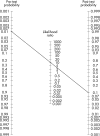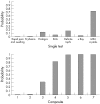EULAR evidence based recommendations for gout. Part I: Diagnosis. Report of a task force of the Standing Committee for International Clinical Studies Including Therapeutics (ESCISIT)
- PMID: 16707533
- PMCID: PMC1798330
- DOI: 10.1136/ard.2006.055251
EULAR evidence based recommendations for gout. Part I: Diagnosis. Report of a task force of the Standing Committee for International Clinical Studies Including Therapeutics (ESCISIT)
Abstract
Objective: To develop evidence based recommendations for the diagnosis of gout.
Methods: The multidisciplinary guideline development group comprised 19 rheumatologists and one evidence based medicine expert, representing 13 European countries. Ten key propositions regarding diagnosis were generated using a Delphi consensus approach. Research evidence was searched systematically for each proposition. Wherever possible the sensitivity, specificity, likelihood ratio (LR), and incremental cost-effectiveness ratio were calculated for diagnostic tests. Relative risk and odds ratios were estimated for risk factors and co-morbidities associated with gout. The quality of evidence was categorised according to the evidence hierarchy. The strength of recommendation (SOR) was assessed using the EULAR visual analogue and ordinal scales.
Results: 10 key propositions were generated though three Delphi rounds including diagnostic topics in clinical manifestations, urate crystal identification, biochemical tests, radiographs, and risk factors/co-morbidities. Urate crystal identification varies according to symptoms and observer skill but is very likely to be positive in symptomatic gout (LR = 567 (95% confidence interval (CI), 35.5 to 9053)). Classic podagra and presence of tophi have the highest clinical diagnostic value for gout (LR = 30.64 (95% CI, 20.51 to 45.77), and LR = 39.95 (21.06 to 75.79), respectively). Hyperuricaemia is a major risk factor for gout and may be a useful diagnostic marker when defined by the normal range of the local population (LR = 9.74 (7.45 to 12.72)), although some gouty patients may have normal serum uric acid concentrations at the time of investigation. Radiographs have little role in diagnosis, though in late or severe gout radiographic changes of asymmetrical swelling (LR = 4.13 (2.97 to 5.74)) and subcortical cysts without erosion (LR = 6.39 (3.00 to 13.57)) may be useful to differentiate chronic gout from other joint conditions. In addition, risk factors (sex, diuretics, purine-rich foods, alcohol, lead) and co-morbidities (cardiovascular diseases, hypertension, diabetes, obesity, and chronic renal failure) are associated with gout. SOR for each proposition varied according to both the research evidence and expert opinion.
Conclusions: 10 key recommendations for diagnosis of gout were developed using a combination of research based evidence and expert consensus. The evidence for diagnostic tests, risk factors, and co-morbidities was evaluated and the strength of recommendation was provided.
Comment in
-
Review: sensitivities and specificities vary for different diagnostic tests of gout.Evid Based Med. 2007 Apr;12(2):56. doi: 10.1136/ebm.12.2.56. Evid Based Med. 2007. PMID: 17400648 No abstract available.
Similar articles
-
EULAR evidence based recommendations for gout. Part II: Management. Report of a task force of the EULAR Standing Committee for International Clinical Studies Including Therapeutics (ESCISIT).Ann Rheum Dis. 2006 Oct;65(10):1312-24. doi: 10.1136/ard.2006.055269. Epub 2006 May 17. Ann Rheum Dis. 2006. PMID: 16707532 Free PMC article. Review.
-
EULAR evidence based recommendations for the management of hip osteoarthritis: report of a task force of the EULAR Standing Committee for International Clinical Studies Including Therapeutics (ESCISIT).Ann Rheum Dis. 2005 May;64(5):669-81. doi: 10.1136/ard.2004.028886. Epub 2004 Oct 7. Ann Rheum Dis. 2005. PMID: 15471891 Free PMC article. Review.
-
EULAR evidence-based recommendations for the diagnosis of hand osteoarthritis: report of a task force of ESCISIT.Ann Rheum Dis. 2009 Jan;68(1):8-17. doi: 10.1136/ard.2007.084772. Epub 2008 Feb 4. Ann Rheum Dis. 2009. PMID: 18250111 Review.
-
2011 Recommendations for the diagnosis and management of gout and hyperuricemia.Postgrad Med. 2011 Nov;123(6 Suppl 1):3-36. doi: 10.3810/pgm.2011.11.2511. Postgrad Med. 2011. PMID: 22156509
-
Italian Society of Rheumatology recommendations for the management of gout.Reumatismo. 2013 Mar 28;65(1):4-21. doi: 10.4081/reumatismo.2013.4. Reumatismo. 2013. PMID: 23550256
Cited by
-
Sutton's Law: A Lesson in Decision-Analysis from the Past…and Present.J Gen Intern Med. 2024 Oct 21. doi: 10.1007/s11606-024-09112-y. Online ahead of print. J Gen Intern Med. 2024. PMID: 39432215
-
Gut Microbiota and Metabolic Syndrome: Relationships and Opportunities for New Therapeutic Strategies.Scientifica (Cairo). 2024 Jul 15;2024:4222083. doi: 10.1155/2024/4222083. eCollection 2024. Scientifica (Cairo). 2024. PMID: 39041052 Free PMC article. Review.
-
Time to redefine hyperuricemia? The serum uric acid cut-off level for precipitation might be lower: a pilot study.Rom J Morphol Embryol. 2023 Oct-Dec;64(4):543-548. doi: 10.47162/RJME.64.4.11. Rom J Morphol Embryol. 2023. PMID: 38184835 Free PMC article.
-
Superiority of Low-Dose Benzbromarone Add-On to Low-Dose Febuxostat Compared With Febuxostat Monotherapy in Gout With Combined-Type Hyperuricemia.Arthritis Care Res (Hoboken). 2024 May;76(5):703-711. doi: 10.1002/acr.25283. Epub 2024 Feb 20. Arthritis Care Res (Hoboken). 2024. PMID: 38130040
-
Gender differences in illness perceptions and disease management in patients with gout, results from a questionnaire study in Western Sweden.BMC Musculoskelet Disord. 2023 Apr 15;24(1):300. doi: 10.1186/s12891-023-06416-8. BMC Musculoskelet Disord. 2023. PMID: 37061681 Free PMC article.
References
-
- Neogi T, Hunter D J, Chasson C E, Cunningham J A, Zhang Y Q. Frequency of inappropriate management of acute gout attacks. Arthritis Rheum 200450(9 suppl)S339
-
- Mikuls T R, Curtis J, Allison J, Hicks R W, Saag K G. Medication errors with the use of gout related therapies: results from the United States Pharmacopeia MEDMARXsm Surveillance System. Arthritis Rheum 200450(9 suppl)S339–S340.
Publication types
MeSH terms
Substances
LinkOut - more resources
Full Text Sources
Medical





